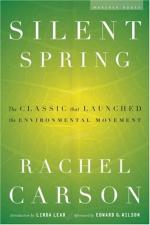|
This section contains 414 words (approx. 2 pages at 400 words per page) |

|
Silent Spring Summary & Study Guide Description
Silent Spring Summary & Study Guide includes comprehensive information and analysis to help you understand the book. This study guide contains the following sections:
This detailed literature summary also contains Bibliography and a Free Quiz on Silent Spring by Rachel Carson.
First published in the United States in 1962, Silent Spring surveys mounting evidence that widespread pesticide use endangers both wildlife and humans. Along the way, Rachel Carson criticizes an irresponsible chemical industry, which continues to claim that pesticides are safe, and imprudent public officials, who accept without question this disinformation. As an alternative to the "scorched earth" logic underlying accepted pest-control practices, the author outlines the "biotic" approach cheaper, safer, longer acting, natural solutions to pest problems (for example, controlling the Japanese beetle by introducing a fungus that causes a fatal disease in this insect).
The primary inspiration for the book was a friend of Carson's who was concerned about dying birds in her hometown where the authorities had sprayed DDT to control mosquitoes. At about the same time, a disastrous pesticide campaign against the fire ant of the Southeast was receiving national attention. Formerly a science writer for the United States Fish and Wildlife Service, Carson already had some acquaintance with research on pesticides, and she was ready to speak out. Originally planned as an article, Silent Spring became a book of more than two hundred pages when the only outlet she could find was the book publisher Houghton Mifflin.
Though Silent Spring is without question her best-known book today, Carson was already a national literary celebrity when it came out. As workof social criticism, Silent Spring represented a considerable departure from the natural history with which she had made a name for herself. Whether this would have been a turning point in her career or merely a detour is impossible to know because Carson succumbed to breast cancer only a year and a half after Silent Spring appeared. What is clear, however, is that her public image was irrevocably transformed. Average Americans came to see her as a noble crusader while the chemical industry would quickly spend more than a quarter of a million dollars to discredit her.
Few books have had as much impact on late twentieth-century life as Carson's Silent Spring. Though an environmental consciousness can be discerned in American culture as far back as the nineteenth century, environmentalism as it is known today has only been around for about forty years, and Carson's book is one of its primary sources. Her tirade against humankind's attempt to use technology to dominate nature wrenched environmentalism from its relatively narrow, conservationist groove and helped transform it into a sweeping social movement that has since impacted almost every area of everyday life.
Read more from the Study Guide
|
This section contains 414 words (approx. 2 pages at 400 words per page) |

|



